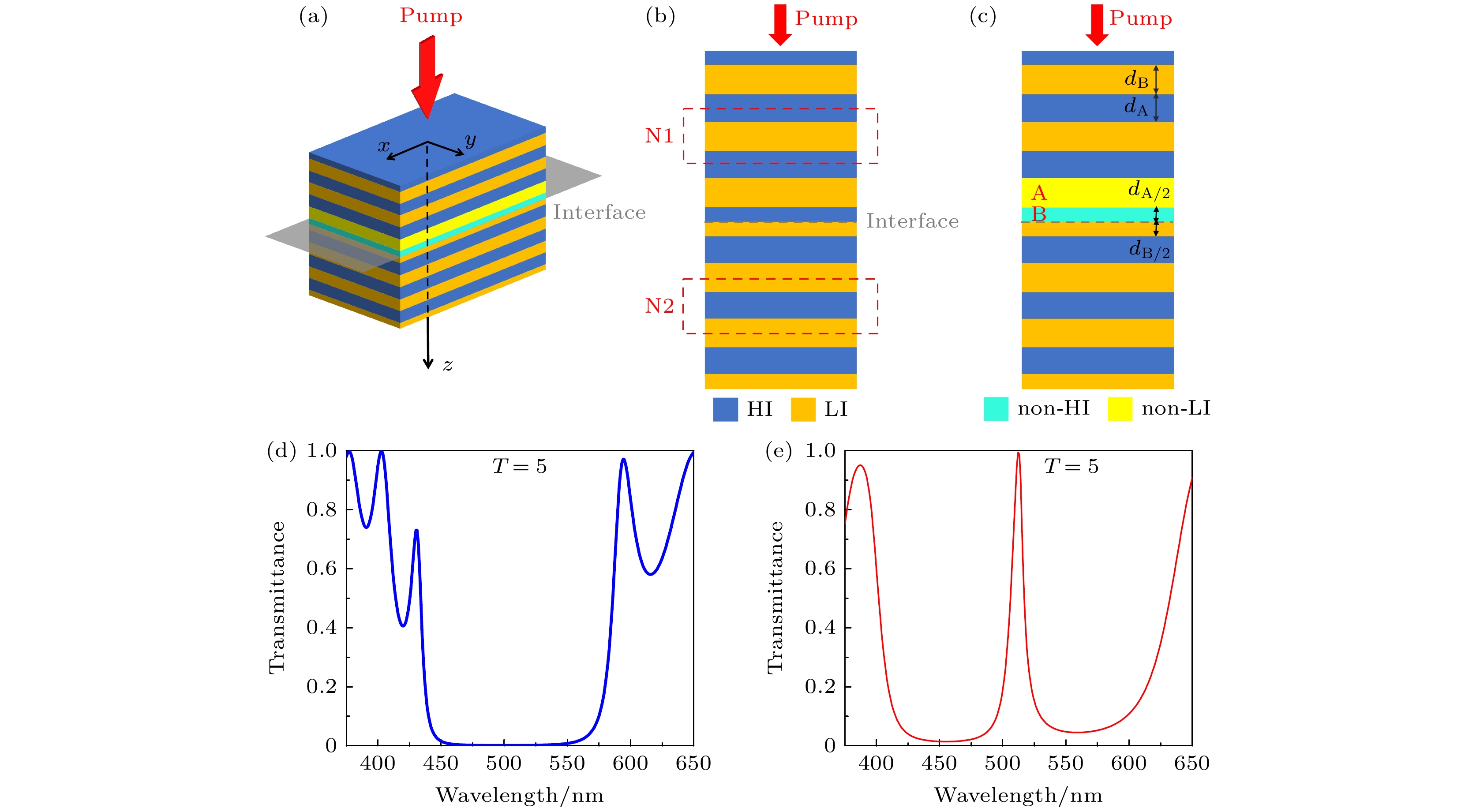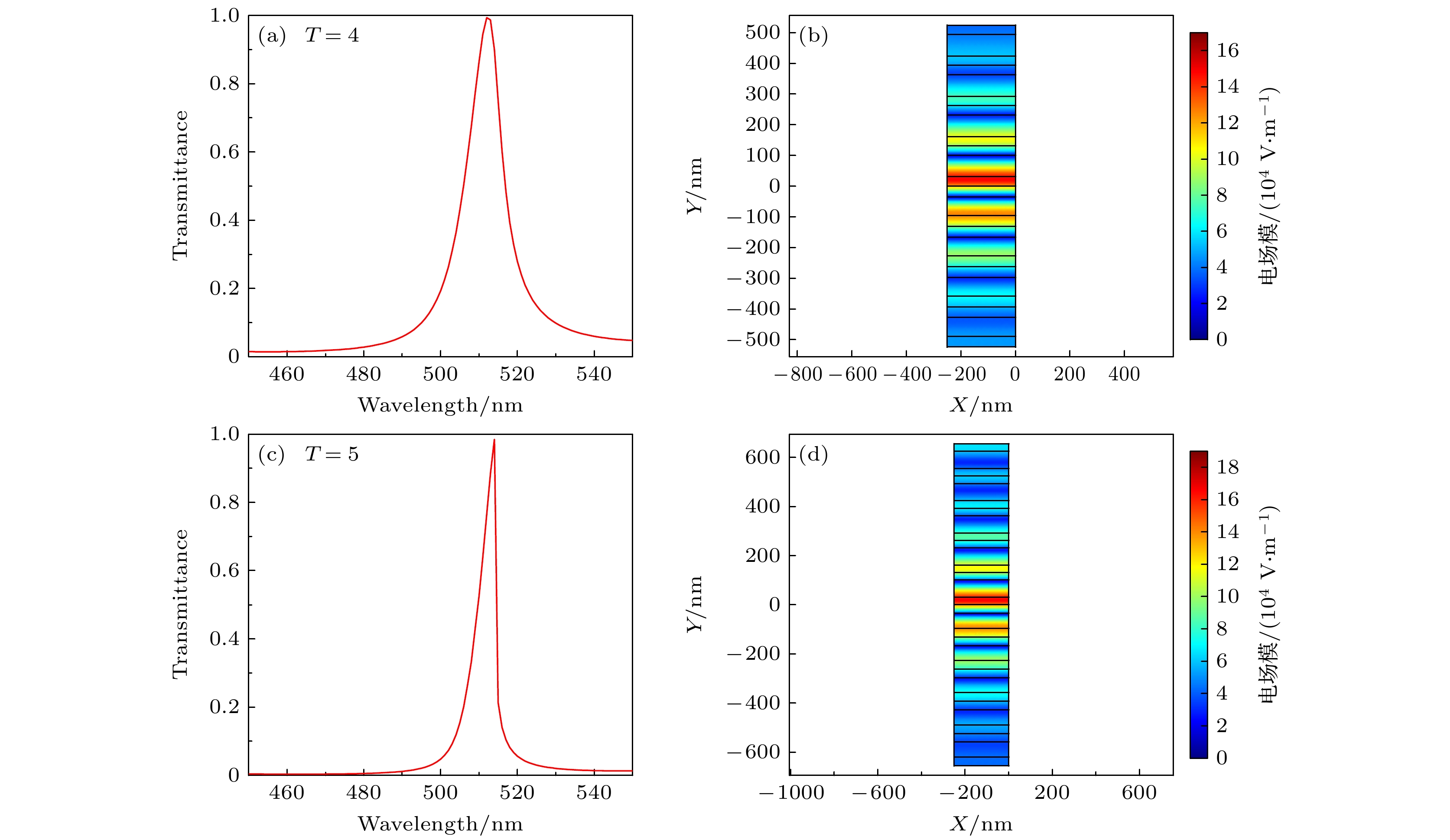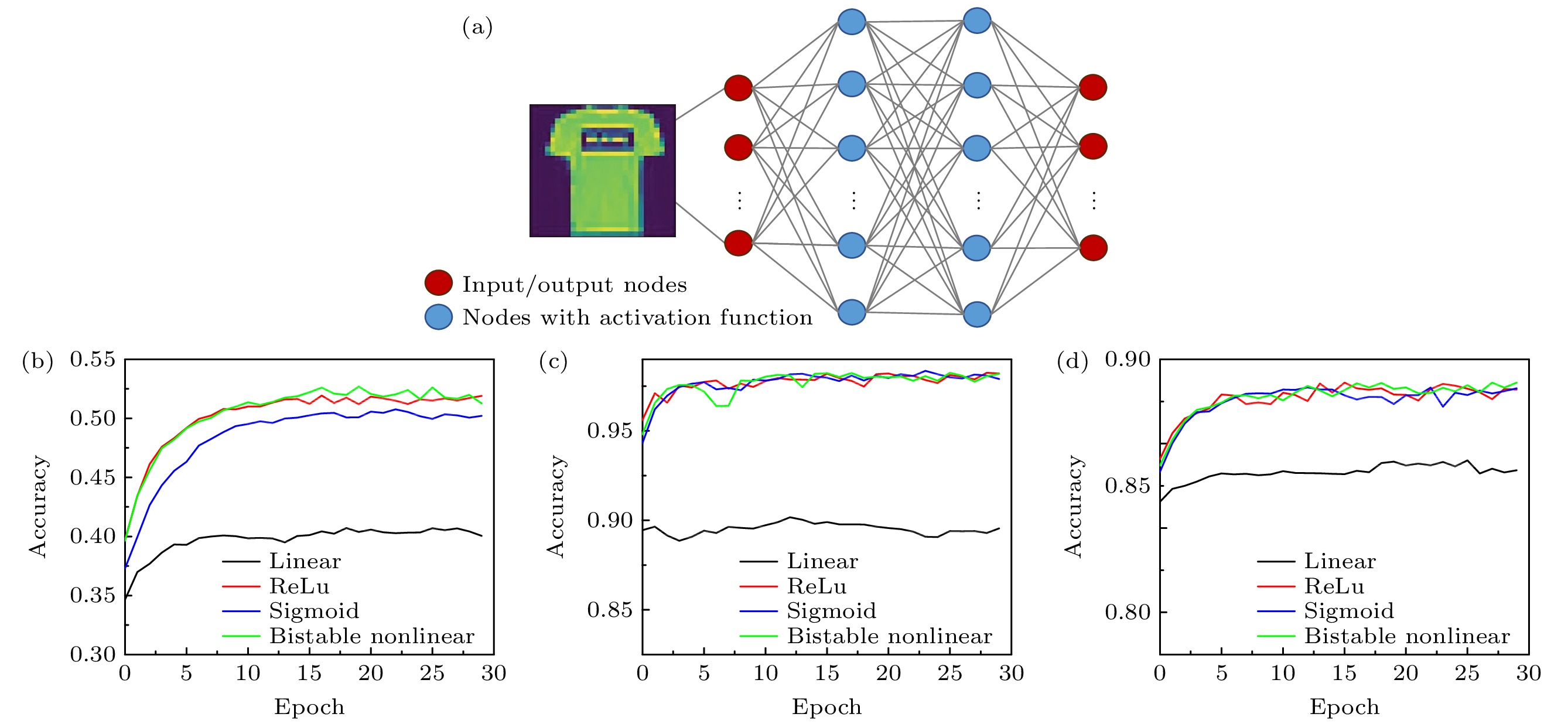-
具有光学双稳态的非线性微纳光学器件在光集成电路和光神经网络中有着重要的应用. 然而, 传统光学双稳态特性会受到内部系统无序和外部系统扰动的影响, 不利于应用. 本文利用SiO2和TiO2的拓扑多层薄膜结构, 在拓扑模式电场强度最大的区域引入非线性介电常数, 探究拓扑模式的光学双稳态特性, 并分析了双稳态特性在层厚度变化和折射率变化下的鲁棒性. 最后, 本文将双稳态特性作为非线性激活函数应用到了光神经网络计算中, 相比于传统的非线性激活函数ReLu和Sigmoid, 双稳态非线性激活函数展示出了更好的图像识别精度. 本文结果对研发下一代鲁棒性强的光神经网络有着重要研究意义.Optical bistable state exhibits its great potential applications in photonic integrated circuit and photonic neural network. However, the traditional optical bistable state will be influenced by the system disorders, which are not suitable for application. In this work, we investigate the topological bistable states in a layered structure with center inversion symmetry consisting of alternating layers of high index material TiO2 and low index material SiO2. In the topological mode, the electric field is highly localized in the inversion center of the layered structure (also known as the interface) and exponentially decays into the bulk. Thus, when the nonlinear permittivity is strategically introduced into those layers, nonlinear phenomena such as the bistable state appears. The finite element numerical simulations reveal that the optimal bistable state appears when the layer period is 5 with a threshold power around 1.2 W/m. Benefiting from the topological characteristics, such a bistable state persists when random perturbations are introduced into the layer thickness and refractive index. Finally, we apply the bistable states to a photonic neural network. The bistable function shows prediction accuracy similar to the classic activation function ReLu and sigmoid in various learning tasks. These results provide a novel method for inserting highly robust optical bistable states from topological layered structure into photonic neural network.
-
Keywords:
- optical bistability /
- topological structure /
- robustness
[1] Chen X 1984 Chin. J. Nat. 10 761 [陈洗 1984 自然杂志 10 761]
Chen X 1984 Chin. J. Nat. 10 761
[2] Notomi M, Shinya A, Mitsugi S, Kira G, Kuramochi E, Tanabe T 2005 Opt. Express 13 2678
 Google Scholar
Google Scholar
[3] Trofimov V A, Egorenkov V A, Loginova M M 2016 Active Photonic Materials VIII, San Diego, California, United States, Suptember 16, 2016 p992029
[4] Ozawa T, Price H M, Amo A, et al. 2019 Rev. Mod. Phys. 91 015006
 Google Scholar
Google Scholar
[5] Moore J E 2010 Nature 464 194
 Google Scholar
Google Scholar
[6] Hasan M Z, Kane C L 2010 Rev. Mod. Phys. 82 3045
 Google Scholar
Google Scholar
[7] Qi X L, Zhang S C 2011 Rev. Mod. Phys. 83 1057
 Google Scholar
Google Scholar
[8] Wang Z, Chong Y, Joannopoulos J D, Soljačić M 2009 Nature 461 772
 Google Scholar
Google Scholar
[9] Li Z, Luo X W, Gu Q 2023 APL Photonics 8 070901
 Google Scholar
Google Scholar
[10] Li Z, Gu Q 2024 Nanophotonics 13 825
 Google Scholar
Google Scholar
[11] Li Z T, Luo X W, Lin D Y, Gharajeh A, Moon J, Hou J P, Zhang C W, Gu Q 2023 Phys. Rev. Lett. 131 023202
 Google Scholar
Google Scholar
[12] Li C, Hu X Y, Yang H, Gong Q H 2017 AIP Adv. 7 025203
 Google Scholar
Google Scholar
[13] Poshakinskiy A V, Poddubny A N, Pilozzi L, Ivchenko E L 2014 Phys. Rev. Lett. 112 107403
 Google Scholar
Google Scholar
[14] Ishida N, Ota Y, Lin W, Byrnes T, Arakawa Y, Iwamoto S 2022 Nanophotonics 11 2169
 Google Scholar
Google Scholar
[15] Lu L, Joannopoulos J D, Soljačić M 2014 Nat. Photonics 8 821
 Google Scholar
Google Scholar
[16] Lu L, Fang C, Fu L, Johnson S G, Joannopoulos J D, Soljačić M 2016 Nat. Phys. 12 337
 Google Scholar
Google Scholar
[17] Verbin M, Zilberberg O, Kraus Y E, Lahini Y, Silberberg Y 2013 Phys. Rev. Lett. 110 076403
 Google Scholar
Google Scholar
[18] Gao W L, Lawrence M, Yang B, Liu F, Fang F Z, Béri B, Li J S, Zhang S 2015 Phys. Rev. Lett. 114 037402
 Google Scholar
Google Scholar
[19] Hafezi M, Mittal S, Fan J, Migdall A, Taylor J M 2013 Nat. Photonics 7 1001
 Google Scholar
Google Scholar
[20] Long X, Bao Y W, Yuan H X, Zhang H Y, Dai X Y, Li Z F, Jiang L Y, Xiang Y J 2022 Opt. Express 30 20847
 Google Scholar
Google Scholar
[21] Psaltis D, Brady D, Wagner K 1988 Appl. Opt. 27 1752
 Google Scholar
Google Scholar
[22] Li Z T, Shan S C, Hu S R, Gu Y Z, Ji X Q, Hou J P 2024 Opt. Mater. Express 14 1398
 Google Scholar
Google Scholar
[23] Tian J, Tan Q Y, Wang Y, Yang Y, Yuan G, Adamo G, Soci C 2023 Nat. Commun. 14 1433
 Google Scholar
Google Scholar
[24] Blanco-Redondo A, Andonegui I, Collins M J, et al. 2016 Phys. Rev. Lett. 116 163901
 Google Scholar
Google Scholar
[25] Weimann S, Kremer M, Plotnik Y, et al. 2017 Nat. Mater. 16 433
 Google Scholar
Google Scholar
[26] Huang Z, Baron A, Larouche S, Argyropoulos C, Smith D R 2015 Opt. Lett. 40 5638
 Google Scholar
Google Scholar
[27] Miscuglio M, Mehrabian A, Hu Z, et al. 2018 Opt. Mater. Express 8 3851
 Google Scholar
Google Scholar
[28] Gosciniak J 2024 IEEE Photonics J. 16 1
 Google Scholar
Google Scholar
[29] Jha A, Huang C, Prucnal P R 2020 Opt. Lett. 45 4819
 Google Scholar
Google Scholar
-
图 1 (a)拓扑层结构三维示意图; (b)未加入非线性材料的三维混合结构纵切面图; (c)加入非线性材料后的切面图, 非线性材料加入到了A、B两层中; (d)周期数T = 5时, 拓扑中心对称结构的透射率-波长谱线; (e) 周期数T = 5时, 镜面对称结构的透射率-波长谱线
Fig. 1. (a) Three dimensional schematic of topological layered structure; (b) cross section view of the topological layered structure; (c) cross section view of the topological layered structure when the nonlinear permittivity is introduced in layer A and B; (d) transmission spectrum of topological layered structure when T = 5; (e) transmission spectrm of mirror-symmetrci layered structure when T = 5.
图 2 (a) T = 4拓扑层结构透射率-波长谱线; (b) T = 4层结构拓扑模式电场分布; (c) T = 5拓扑层结构透射率-波长谱线; (d) T = 5层结构拓扑模式电场分布
Fig. 2. (a) Transmission spectrum of the topological mode at T = 4; (b) electric field mode distribution of the topological mode at T = 4; (c) transmission spectrum at T = 5 of the topological mode; (d) electric field mode distribution of the topological mode at T = 5.
图 6 (a) 全连接深度神经网络结构示意图, 其中包括二维图像的输入层, 两个节点数为400和200的隐藏层以及输出层, 这些隐藏层分别使用4种不同的激活函数: 无激活函数、Relu、Sigmoid和双稳态曲线. (b)—(d) 4种激活函数在不同数据集上的表现 (b) CIFAR-10; (c) MNIST; (d) FashionMNIST
Fig. 6. (a) Schematic of a fully connected deep neural network architecture, which includes an input layer for a 2D image, two hidden layers with 400 and 200 nodes, and an output layer, these hidden layers use four different activation functions: no activation function, Relu, Sigmoid, and bistable curve. (b)–(d) Performance of four activation functions on different datasets: (b) CIFAR-10; (c) MNIST; (d) FashionMNIST.
-
[1] Chen X 1984 Chin. J. Nat. 10 761 [陈洗 1984 自然杂志 10 761]
Chen X 1984 Chin. J. Nat. 10 761
[2] Notomi M, Shinya A, Mitsugi S, Kira G, Kuramochi E, Tanabe T 2005 Opt. Express 13 2678
 Google Scholar
Google Scholar
[3] Trofimov V A, Egorenkov V A, Loginova M M 2016 Active Photonic Materials VIII, San Diego, California, United States, Suptember 16, 2016 p992029
[4] Ozawa T, Price H M, Amo A, et al. 2019 Rev. Mod. Phys. 91 015006
 Google Scholar
Google Scholar
[5] Moore J E 2010 Nature 464 194
 Google Scholar
Google Scholar
[6] Hasan M Z, Kane C L 2010 Rev. Mod. Phys. 82 3045
 Google Scholar
Google Scholar
[7] Qi X L, Zhang S C 2011 Rev. Mod. Phys. 83 1057
 Google Scholar
Google Scholar
[8] Wang Z, Chong Y, Joannopoulos J D, Soljačić M 2009 Nature 461 772
 Google Scholar
Google Scholar
[9] Li Z, Luo X W, Gu Q 2023 APL Photonics 8 070901
 Google Scholar
Google Scholar
[10] Li Z, Gu Q 2024 Nanophotonics 13 825
 Google Scholar
Google Scholar
[11] Li Z T, Luo X W, Lin D Y, Gharajeh A, Moon J, Hou J P, Zhang C W, Gu Q 2023 Phys. Rev. Lett. 131 023202
 Google Scholar
Google Scholar
[12] Li C, Hu X Y, Yang H, Gong Q H 2017 AIP Adv. 7 025203
 Google Scholar
Google Scholar
[13] Poshakinskiy A V, Poddubny A N, Pilozzi L, Ivchenko E L 2014 Phys. Rev. Lett. 112 107403
 Google Scholar
Google Scholar
[14] Ishida N, Ota Y, Lin W, Byrnes T, Arakawa Y, Iwamoto S 2022 Nanophotonics 11 2169
 Google Scholar
Google Scholar
[15] Lu L, Joannopoulos J D, Soljačić M 2014 Nat. Photonics 8 821
 Google Scholar
Google Scholar
[16] Lu L, Fang C, Fu L, Johnson S G, Joannopoulos J D, Soljačić M 2016 Nat. Phys. 12 337
 Google Scholar
Google Scholar
[17] Verbin M, Zilberberg O, Kraus Y E, Lahini Y, Silberberg Y 2013 Phys. Rev. Lett. 110 076403
 Google Scholar
Google Scholar
[18] Gao W L, Lawrence M, Yang B, Liu F, Fang F Z, Béri B, Li J S, Zhang S 2015 Phys. Rev. Lett. 114 037402
 Google Scholar
Google Scholar
[19] Hafezi M, Mittal S, Fan J, Migdall A, Taylor J M 2013 Nat. Photonics 7 1001
 Google Scholar
Google Scholar
[20] Long X, Bao Y W, Yuan H X, Zhang H Y, Dai X Y, Li Z F, Jiang L Y, Xiang Y J 2022 Opt. Express 30 20847
 Google Scholar
Google Scholar
[21] Psaltis D, Brady D, Wagner K 1988 Appl. Opt. 27 1752
 Google Scholar
Google Scholar
[22] Li Z T, Shan S C, Hu S R, Gu Y Z, Ji X Q, Hou J P 2024 Opt. Mater. Express 14 1398
 Google Scholar
Google Scholar
[23] Tian J, Tan Q Y, Wang Y, Yang Y, Yuan G, Adamo G, Soci C 2023 Nat. Commun. 14 1433
 Google Scholar
Google Scholar
[24] Blanco-Redondo A, Andonegui I, Collins M J, et al. 2016 Phys. Rev. Lett. 116 163901
 Google Scholar
Google Scholar
[25] Weimann S, Kremer M, Plotnik Y, et al. 2017 Nat. Mater. 16 433
 Google Scholar
Google Scholar
[26] Huang Z, Baron A, Larouche S, Argyropoulos C, Smith D R 2015 Opt. Lett. 40 5638
 Google Scholar
Google Scholar
[27] Miscuglio M, Mehrabian A, Hu Z, et al. 2018 Opt. Mater. Express 8 3851
 Google Scholar
Google Scholar
[28] Gosciniak J 2024 IEEE Photonics J. 16 1
 Google Scholar
Google Scholar
[29] Jha A, Huang C, Prucnal P R 2020 Opt. Lett. 45 4819
 Google Scholar
Google Scholar
计量
- 文章访问数: 4992
- PDF下载量: 93
- 被引次数: 0















 下载:
下载:





